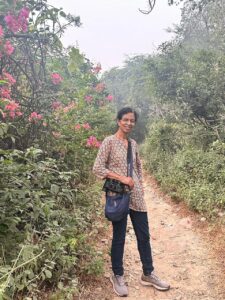by Joe & Meera Sundharam
Delhi ridge, or simply the Ridge, is an extension of the ancient Aravalli Range. The northern part of the ridge which is close to the Delhi University is named Kamala Nehru Ridge. The Bonta Park is a forested area at the Kamla Nehru Ridge.
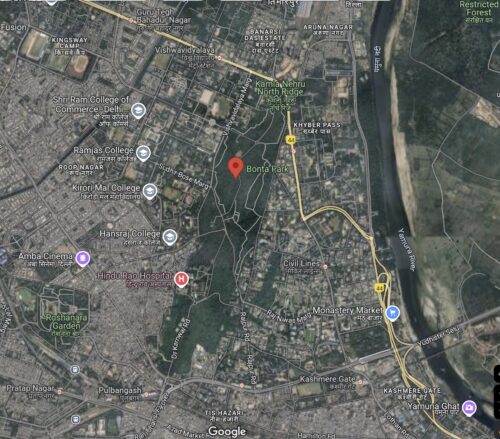
We have visited it every few months for the past many years on our early morning bird walks, but on 27th Oct 2024 we had a memorable experience….
Our daily morning walks are a leisurely ritual, typically meandering through the various parks of Pitampura and Saraswati Vihar. However, on Sundays, we venture further afield to Buddha Jayanti or Nehru Park and sometimes the scenic walking trails along the Ridge near Delhi University. Today was no exception; we rose early—at 3:50 AM to be precise—and prepared for our adventure on the Ridge. Meera whipped up a breakfast snack: fish paste on toasted buttered bread for me and cheese for her, accompanied by a flask of tea. This breakfast ritual which we enjoyed in the car after an hour of walking, was something we looked forward to on our visits to these more distant parks.
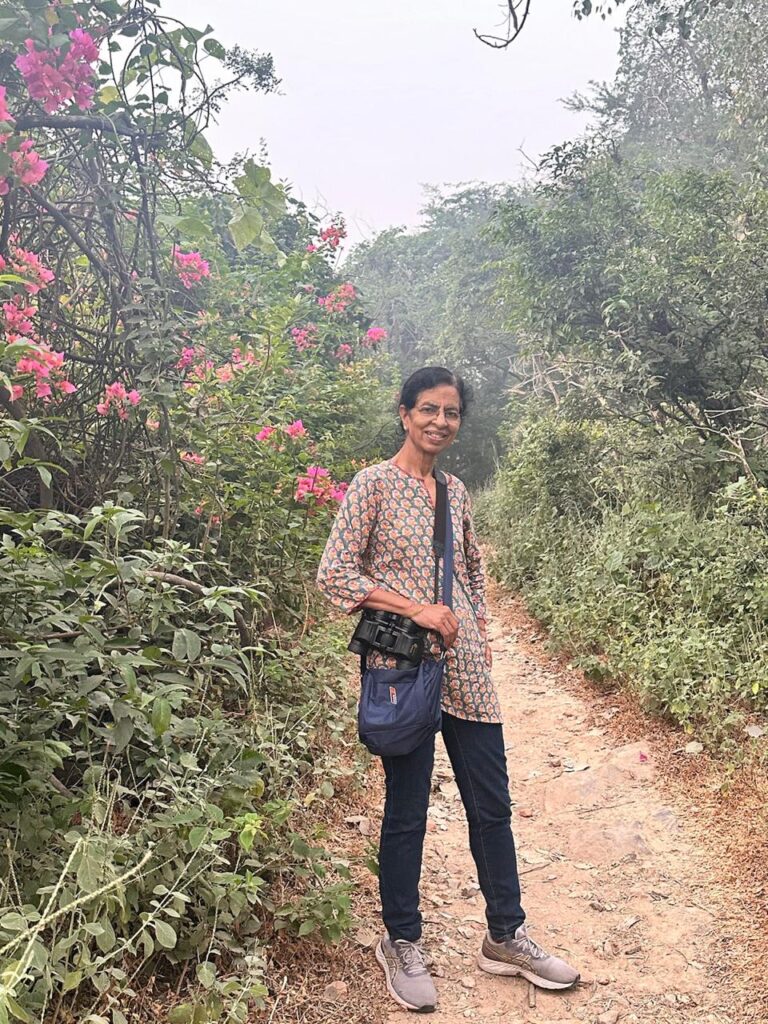
It took us about forty minutes to cover the roughly 13 kilometres to the Ridge. The early morning was still shrouded in darkness, with only a few parked cars and hardly any people in sight. We could hear the chatter of monkeys, and as we entered the gate to the Ridge, we were greeted by troops of screeching, squabbling monkeys scampering about or lounging casually in the middle of the road. Given the darkness, we opted against our usual side trails through the forest and instead walked along the paved main road toward Flagstaff Tower.
Monkey Menace vs Monkey Penance
The monkey population seemed to have exploded since our last visit a few months ago; the air was thick with a damp, ammoniacal smell, and patches of monkey urine marked almost the entire stretch of road. We carefully navigated the monkeys lounging in our path and the many dogs strategically sleeping in the middle of the road, yielding to morning joggers. We crossed Flagstaff Tower and continued along the paved road toward Kashmere Gate. The sheer number of monkeys was astonishing—literally in the thousands—with groups squabbling for territory and youngsters howling.
“Don’t look at them,” I advised Meera. “They won’t be aggressive unless they feel threatened.”
We stuck to the main paved paths as dawn began to break, then veered toward Rajpur Road and entered a wooded trail near Gate No. 3. Passing by the Butterfly Park, we were disappointed to find it locked, with not a single butterfly visible through the park’s grilles. After climbing back up the trail, we finally reached our car at Gate No 1, eager to enjoy our breakfast.
Once we finished, we set off for another round of the Ridge. With daylight fully upon us, we decided to explore the more forested, unpaved side paths. About 500 meters down the trail, we encountered an area where water was flowing across the path, turning it into muddy slush—likely due to a leaky pipe nearby. Beyond that was a fallen tree surrounded by a noisy troop of monkeys obstructing our way.
“It looks like this path is blocked; we’ll have to turn around,” I said.
“There’s a path beyond the tree,” Meera pointed out.
“There may be,” I replied, “but there are too many monkeys, and navigating through them could be dangerous. Let’s head back.” We turned around and had just started walking when we noticed a well-built, middle-aged gentleman with salt-and-pepper hair approaching us. As he passed by, I called out, “The road ahead seems blocked.”
“Blocked? No way! This is the “Golden Path”—it’s never blocked!” he replied confidently.
He continued on, saying, “Follow me.” We followed him as he skirted the muddy area, picked up a short stick from the ground, and deftly shifted some overhanging branches of a keekar tree. Holding the stick up, he gestured for us to duck under the branches. He then emitted some loud, harsh, deep-throated sounds to threaten the monkeys while raising his stick in a menacing manner. The monkeys snarled, baring their teeth but quickly scattered, making way for us to proceed.
As we walked along the path, he waved us to follow. “We developed this path,” he explained. “We created these paths all around.”
“In 2006, we initiated a campaign to remove the monkeys from the ridge,” he continued. “The then MCD Commissioner brought in some expert monkey catchers from Tamil Nadu who specialized in catching and relocating monkeys. We were able to remove all of them except for two or three.”
“The problem lies with the local banias,” he added. “They regularly feed the monkeys as penance for their sins, hoping that their businesses will flourish.”
“First they commit sins during their business dealings and then seek God’s forgiveness,” I remarked.
A History Lesson
“True,” he laughed and enquired “Are you interested in history?”
“Yes,” we replied eagerly.
“Well, you know that George Pancham (referring to King George V) – came to India in 1911 for his Coronation as Emperor of India?”
We didn’t know this but nodded our heads in unison and made appropriate sounds of acknowledgment.
“He arrived in Calcutta by ship and then travelled by train to Delhi. A special track was commissioned from Old Delhi Railway Station to Khyber Pass to transport the king to Coronation Park beyond Nirankari Colony. That line passed through this ridge. I’ll show you the foundation stone laid by the railway engineers; it’s just ahead.” He suddenly stopped, moved a few branches of a keekar tree aside, and pointed. There, partly obscured by vines, we saw an inscription on red sandstone that read: We were astounded. Over the past few years, we had been regular visitors to the ridge and had passed this very spot on every visit without ever noticing this stone plaque.
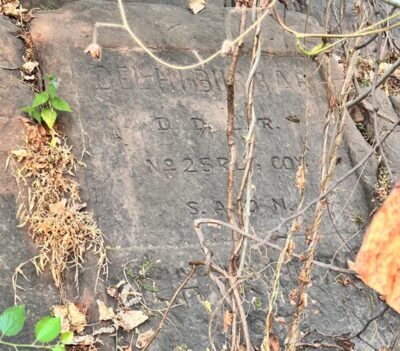
“This is amazing!” I exclaimed.
“D.D.L.R. stands for Delhi Durbar Light Railway. There’s actually another stone next to this one on the left with an inscription,” he explained while attempting to shift the thick overhanging vines and branches. He gave up trying to expose this stone. “This area has been neglected; plants have overgrown these stones but it’s right here obscured by this foliage,” he declared.
“You know, I wrote to Archaeological Survey of India (ASI) at least twice to inform them that these plaques are of historical significance but they didn’t even acknowledge my letters; as a result these stones have remained neglected,” he continued.
It is a Small World
“We’re so happy to have met you, we would never have known!” I exclaimed.
“This feels just like a historical London Walk—thank you for sharing all this information,” Meera said, recalling the many insightful guided tours we had enjoyed just a couple of months ago in London.
He resumed walking as we followed him along a winding path that led upward as he quickened his step. We tried to keep pace behind him in single file. I turned to look at Meera; she nodded indicating she could keep up. Suddenly he turned and asked, “What do you both do?”
“We’re doctors,” I replied.
“And where do you live?”
“In Saraswati Vihar, Pitampura,” I answered. “We love birdwatching and walking so we come to the ridge two or three times a year; I’m familiar with this area because I stayed at Shri Ram College as a child—my father was a lecturer there.”
“And what do you do now?” I inquired.
“I ran a business for many years but now my son manages it.”
“So you’re retired?”
“Oh I’m neither tired nor retired,” he said with a smile. “These are the best years of one’s life!”
“And where do you live?” I asked.
“Roop Nagar.”
“I know Roop Nagar well,” I said. “When I stayed at Shri Ram College I used to cycle around Kamla Nagar, Roop Nagar and all those areas.”
“What is your name?” I asked.
“Shwet Kamal,” he replied.
“And yours?”
“My name is Sundharam.”
He suddenly stopped and turned around: “Are you the son of the famous Mr K.P.M Sundharam?”
“Yes,” I said proudly. “He is my father.”
Shwet Kamal bowed reverentially: “I guessed it moment you mentioned name—it’s a small world. He was our Guru – we read his books!”
“He passed away three years ago at age 97; I’m sure he would have loved to meet you!”
We soon reached paved road at Khyber Pass gate where we bid farewell thanking him for guided tour of ridge before continuing along unpaved path in forested area on other side. As we walked away we saw him walking backward (retrowalking) up paved road toward Flagstaff tower.

Lotus at Lake in the Ridge
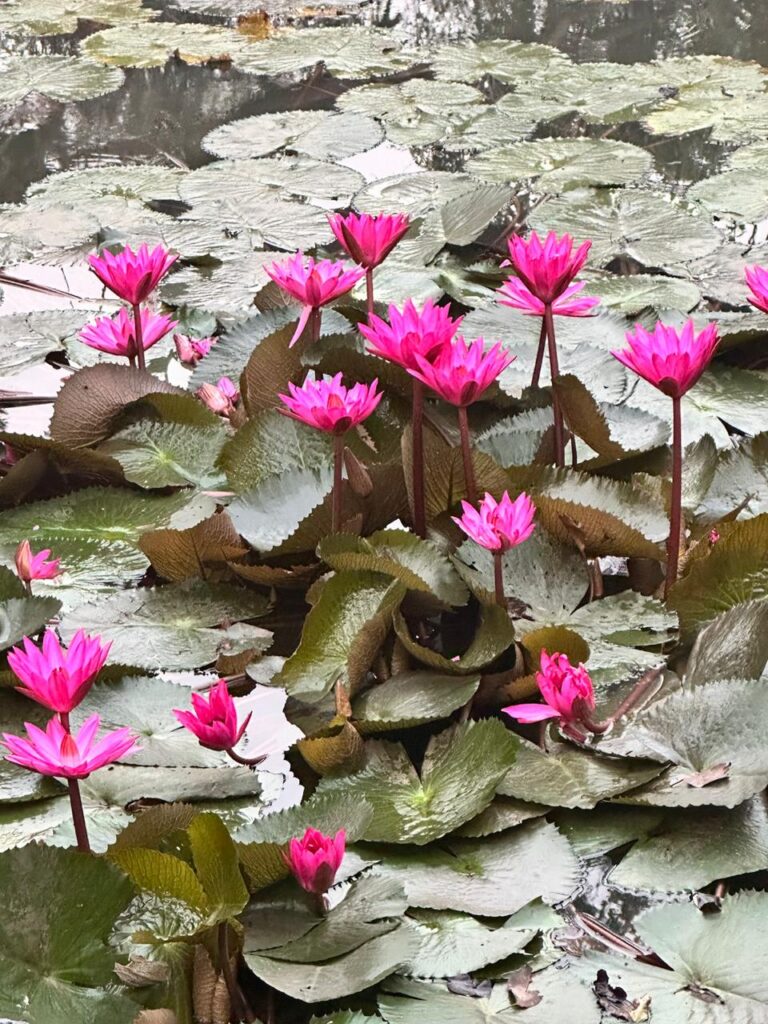
References
- King George V’s Coronation
https://en.wikipedia.org/wiki/Coronation_Park,_Delhi - Delhi Durbar 1911 Railway
https://wiki.fibis.org/w/Delhi_Durbar_1911_Railway#:~:text=The%20ceremonies%20lasting%20from%207,lifted%20after%20the%20Durbar%20ended.
